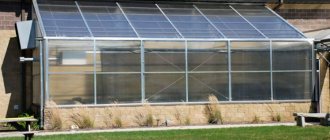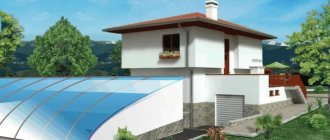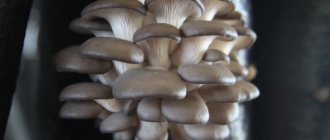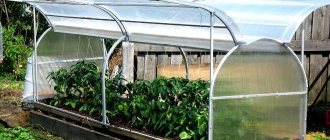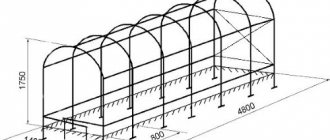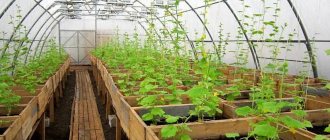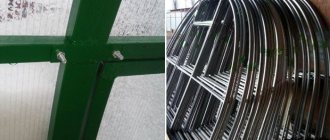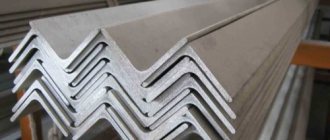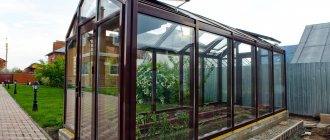Growing various vegetable, green and berry crops, as well as mushrooms, in the basement is an extremely interesting and profitable activity that allows you to effectively use auxiliary premises. At the end of the 19th century, the first experiments were carried out. In those days, gas burners and kerosene lamps were used for lighting.
When the weather is cold outside and nothing grows in the garden, you should pay attention to the cellar, which can be used for your own purposes, because there is a constant positive temperature all year round. Sometimes the most unexpected crops are cultivated in the basement; many are not even aware of this possibility.
Features of growing cucumbers
The first experience of successfully growing vegetables in the basement was obtained at the end of the 19th century. Then, to create suitable conditions, kerosene lamps, gas burners and other similar devices were used.
Today, the life of gardeners has become much simpler - xenon, fluorescent and conventional incandescent lamps can be used to warm the air. It was experimentally found that 1 square meter of basement can produce up to 180 kg of vegetable harvest per year. At the same time, the standard result for open ground is much more modest and amounts to only 3-4 kg from the same area. Of course, such indicators are encouraging! And even if your results turn out to be less impressive, you will be able to get healthy and tasty products at any time of the year.
The main problem you will have to face is creating the necessary lighting regime. And if the cultivation of some mushrooms, for example, champignons, can be carried out in conditions of constant darkness, then cucumbers definitely need light.
Video
You can also watch a video where an experienced gardener will show you how cucumbers and tomatoes grow in the basement in winter.
Thus, we can conclude that the yield of basement greenhouse cucumbers is much higher when grown under other conditions. In such a situation, a stable climate component of the basement plays an important role. There is a balance of moisture and heat, there are no parasitic insects. All these factors contribute to the cultivation of high-quality cucumbers in large quantities.
Basement preparation
Before you begin outfitting your greenhouse, make sure your basement meets the following requirements.
If the temperature drops too low in winter, you need to insulate the walls and floor. To do this, you can use any available insulating materials. In addition, regularly warm up the room using space heaters or other heating devices.
In a basement adapted for growing vegetables, there should be no drafts, so all cracks should be sealed.
It is impossible to successfully grow vegetables in a leaky basement. Before building a greenhouse, make sure that you have sealed all holes and set up the ventilation system.
If you find insects, rats or moles, use any method to eliminate them. For the basement, it is recommended to use smoke bombs, dusts or traps with poisoned baits. When all pests are destroyed, carry out general cleaning and minor repairs. Wash the floor, wipe down and paint the walls. To prevent insects, you can use special paints that contain insecticides.
How to deal with rodents and other pests?
It is extremely important to fight mice, rats, insects and other pests in the basement, as they can cause great damage to plantings. Mousetraps are installed in the basement against rodents and poisonous baits are laid out. For these small animals, the odors emanating from cats are extremely unpleasant.
Treatments with special chemicals will protect against insects. You can use traditional methods. Slugs are caught in traps made of wet rags and then collected by hand. Sprinkling the floor in the basement with mustard, slaked lime, chalk or ash is effective.
Creating a greenhouse
Any greenhouse begins with a nutrient medium, which serves as a source of nutrients for plants. Typically, specially fertilized soil is used for these purposes. Of course, it can also be used in the basement of the house. But this is not recommended due to the large volume, difficulty of loading and the possible occurrence of pests. Moreover, such a greenhouse will require special, expensive care.
Example of equipment for hydroponics.
The hydroponic method is optimal for underground conditions. It involves the abandonment of soil and the use of other substrates that create an artificial environment. Quartz and granite gravel are perfect for the root system of cucumbers. The size of each particle should be between 5 and 20 mm.
The mixture you choose must contain calcium, potassium, magnesium, phosphorus, zinc, manganese and boron. From such a substrate, plants will be able to obtain all the necessary substances.
After solving the issue with the nutrient medium, it is necessary to address the problem of lighting. For normal growth, cucumbers require 10 hours of light per day, taking into account the fact that 1 day in the basement is equal to 18 hours.
heated floor under laminate, electric film
Lamps suitable for use in a basement greenhouse.
It is convenient to use incandescent lamps and mercury arc lamps as a source of lighting in the basement. The ratio of their power should be 67 and 33%. On average per 1 sq. m. you need 1-1.2 kW/h.
Maintaining the light mode manually is quite inconvenient. A time relay will help to avoid this difficulty. You only need to make the necessary settings once. After this, the device will do all the work automatically.
Answer
Hello Marina. Many amateur gardeners, and even professional agronomists, have attempted to grow vegetables in non-standard conditions. These conditions include any room with partial or complete absence of natural light. And if scientists are interested in the use of underground workings, then private homeowners are thinking about how to effectively use the basement in their own home.
- The basement differs favorably from the mine in that it can be well insulated, provided with heating if necessary, and equipped with artificial lighting. It is possible to grow vegetables in such conditions, but there are certain nuances. For example, greens grow without problems: lettuce, sorrel, dill, onions. With cucumbers and tomatoes it is much more difficult - growing them together in the basement will not work. These crops require different amounts of light time. For tomatoes this is 12 hours, cucumbers require 10 hours.
- To maintain such a lighting regime, you will have to install a timer in the basement that will turn the lights on and off at a certain time. DRL, fluorescent and LED lamps can be used as a constant source of lighting. The price of the latter option is the highest, but the energy savings are such that the use of LEDs can reduce the cost of vegetables.
- If we take into account that in the basements there are still small windows that let in sunlight, then for illumination you can use less powerful lamps than for a greenhouse that is in complete darkness around the clock. Good lighting for plants is necessary, but providing them with the right substrate is equally important. If you use regular soil, you can introduce pests, pathogens, and mold spores into the greenhouse. In this regard, scientists developed a hydroponic method: growing plants on artificial nutrient media.
- For example, quartz gravel with a fraction of 8-12mm is used as a basis, and plant nutrients are obtained from a special solution. When growing cucumbers and tomatoes, the process is divided into two technologies: seedlings and fruit-bearing plants. A separate sector is allocated for seedlings, where up to a hundred sprouts can be obtained per 1 m2. To equip it, you can take an asbestos-cement pipe, sawn lengthwise, or a small concrete sewer tray - they are filled with a layer of gravel 20 cm thick.
- Containers with nutrient solution are placed slightly above the gravel trays. The solution enters hydroponic trays, which must be installed with a slight slope, by gravity, after which it flows into a special tank, from which it is then pumped back into the feeding container. The nutrient solution contains potassium, nitrogen, magnesium, phosphorus, and calcium. The composition of the solution and the ratio of fertilizers changes depending on the development phase in which the plants are located. To grow cucumbers like this, you also need to choose a variety that does not need pollination - after all, there are no bees in the basement.
Growing stages
Growing cucumbers at home can be divided into 2 stages: preparing seedlings and directly growing the plants.
How to properly prepare seedlings for planting?
In order for the seedlings to germinate faster, the lamps are placed directly above the containers.
The seedlings will be ready for planting in 3-4 weeks. When it is strong enough, you can immediately move it to the greenhouse. It is necessary to place 4 plants per square meter on the substrate at all times. Dig holes in advance, the dimensions of which will be equal to the containers with seedlings. Carefully cut the cups and transfer their contents to the hole. Then sprinkle the seedlings with a little soil and lightly compact them. Further care of the crops is very simple. Water them as the soil dries out (about 1-2 times a week), feed them with fertilizers once a month and do not forget about the correct light regime.
Although seedlings are usually planted in May, an underground greenhouse allows you to deviate from the deadlines. You can plant the seedlings any time they are ready.
What are the hydroponic methods for strawberries?
There are plenty of methods for using hydroponics, but the most common and accessible is the drip growing system. The seedlings are planted in a special substrate. Regular supply of liquid nutrients supplies the root part of the plants with all the necessary elements.
Having familiarized yourself with drip technology step by step, it will be quite simple to install the equipment and start growing strawberries. This installation requires the following equipment:
- large pipe with drilled holes;
- water pump - the correct design of the mechanism facilitates the process of draining the liquid;
- plastic boxes, which are made in the shape of a recessed bowl;
- polyethylene bags;
- droppers for special composition;
- rubber hoses;
- opaque film;
- nutritional composition;
- small plastic cups for seedlings.
Advantages and disadvantages
Experts and experienced summer residents say that even beginners can count on 60 kg of cucumbers collected from 1 sq.m. with a properly organized greenhouse and prepared seedlings. This figure is several times higher than the average data for harvesting at a summer cottage. In addition to this fact, there are several other advantages because of which this method of growing vegetables has gained popularity.
Of course, this method also has negative sides. The main disadvantage is high energy costs. You can cut them down a bit by switching to LED bulbs. But, unfortunately, most homeowners come to the conclusion that such high costs are not justified from an economic point of view.
Thus, growing cucumbers in a greenhouse equipped in the basement of a house is an easy way to provide yourself and your family with natural products. By taking the time to study the recommendations and implement the project, you can be sure of an excellent result.
Agronomist-plant grower, site consultant on the cultivation and storage conditions of vegetables, fruits and mushrooms.
Source
Advantages and disadvantages
The technique of planting cucumbers in the basement is so simple that even beginners can easily master it. At the same time, the vegetable yield can reach 60 kg of cucumbers collected from 1 m². area. And this is all provided that the greenhouse is properly prepared and the seedlings are grown correctly. Even at a summer cottage, such a harvest will be much smaller.
Dacha these days is a fashionable pastime that provides its owners with fresh and pickled vegetables for every taste. Many of them require greenhouses to grow. In this article you can learn how to build a greenhouse out of wood yourself.
In addition, there are some other advantages of this method:
- The yield of cucumbers will be observed all year round and even in winter.
- Greenhouse cucumbers contain more vitamin C than store-bought vegetables.
- In the basement, seedlings grow faster than in greenhouses on the ground. Under normal conditions, seedlings sprout in 30-35 days; in the basement the same process will be a week shorter. In just two months you will be able to harvest your first harvest.
What can you grow in your basement?
Almost every second private house has a basement. Many families store vegetables and fruits, various pickles and preserves in the underground. Someone equips a cinema or a mini-gym in the basement... But for others, the basement is still only a storage area for unnecessary things that have served their purpose. Such a room can be used in a more worthy and useful way for the family. For example, growing plants or mushrooms in the basement for the needs of the family. And if you organize everything on a grand scale, you can get additional income.
Here are some ideas for what you can grow in your basement.
Benefits of growing onions hydroponically
Forcing onions into plumes in winter using hydroponics will allow you to quickly grow green leaves at low cost. The growth rate and yield of greens in hydroponics is 2 times higher than when grown in soil.
For cultivation, you need to select onion heads that are at least 3 cm in diameter, clean, without cuts or rot.
To quickly germinate green onion feathers, a device is used that consists of three parts: a sprayer, a large tank and a compressor.
The method of hydroponics at home is quite simple - the surface of the tank is covered with a sheet of foam with holes cut in it to the size of the bulb.
The first thing to do is place the selected bulbs in a tank of water for bubbling. A compressor is lowered into the water, which passes oxygen into the water. This process lasts 8-12 hours, during which the plant is saturated with oxygen for further growth. It is noteworthy that after the procedure, small roots can already be observed at the base of the bulb.
At the end of bubbling, the onion must be slightly dried, and a small layer of the top must be cut off to facilitate feather growth. Place the finished material on polystyrene foam and place it on a tank of water. For onions to grow well, they need air. To do this, a sprayer is placed at the bottom of the tank, to which a compressor is connected. The temperature of the water in the container should not be lower than 23 degrees.
If you plan to grow onions in the basement on your own, you need to take care of the lighting - onions will not grow in complete darkness.
Using the hydroponics method for growing greens, you can get a decent harvest in 2 weeks.
Pay attention to the basement
After the onset of cold weather and the end of the dacha season, you can continue gardening chores. But move them to the basement. Moreover, this idea is by no means new. Vegetables and herbs were grown in cellars and basements two centuries ago. When kerosene lamps were used for lighting.
Growing in the basement: pros and cons
Basement farming has a number of advantages:
This method of gardening has one drawback - the cost of electricity for lighting and heating.
Growing in the basement: preparing the room
Before you begin directly growing in the basement, you should assess its condition. And, if necessary, carry out appropriate preparatory work.
How to properly care for cucumbers?
After planting a vegetable crop in a permanent place in the basement, you must:
- Prepare a trellis or other device for tying cucumber vines. Tying should be done regularly as the shoots grow. Lighting is also adjusted by raising the lamps to a different level in relation to the plants.
- As soon as the first flower appears on the shoots, the vines begin to blind. To do this, pluck out at the base of the bush several flowers that appeared first. The procedure allows cucumbers not to stop growing, but to stretch upward and produce new ovaries. Removing the first greens leads to the fact that the lower part of the stem is exposed. It is better to lay this part of the shoot on the ground and tie the fruiting vines to a trellis. Forming a bush into one stem is the best option for winter growing cucumbers in the basement.
- To extend the fruiting period, fertilize the soil. Water with mullein solution, alternating with mineral complexes. In the initial periods of the growing season, the solutions are made weak so as not to burn the plants. Later, nutrient solutions become more concentrated. If at first mullein is diluted in a concentration of 1:8, then - 1:4. Of the mineral fertilizers per bucket of water, 10 grams of ammonium nitrate and potassium chloride, 30 grams of superphosphate are enough. Then double the amount. Feed once every 7-10 days.
- The roots of cucumbers are often exposed, which is why soil is constantly added in a layer of 2–3 centimeters.
- Water the cucumbers only with warm water at a temperature of 25 degrees. To wet the entire soil layer, you will need up to a bucket of water per square meter of shelving.
- Cucumbers begin to grow faster when the air is supplied with carbon dioxide. You can increase its content in the basement by placing containers with cow manure in the room. If possible, you can hang dry ice cubes or place hard pieces next to the plants. You can enrich the room with carbon dioxide not only during the fruiting period of cucumbers, but also when growing seedlings and planting them in the ground.
Greens are obtained early in the basement if the rules for growing vegetables are followed.
What can you grow in the basement?
Growing green crops
Onions, parsley, dill, and salads can be grown not only for personal consumption. But also for sale.
soft floor slabs
To obtain full, intensely colored greens, it is important to provide good lighting. It is better to use phytolamps or fluorescent lamps for it. Onions can be grown on a substrate, for example, sunflower or rice husks, clean sand. Which is soaked in a nutrient solution. Depending on the variety, the feather yield ranges from 45 to 100% of the weight of the planted bulbs. If we take into account that the cost of green onions is 5-7 times higher than the price of onions, then the economic efficiency is obvious.
Green crops can be grown hydroponically or in special pots with substrate. Which is periodically flooded with a nutrient solution.
Growing vegetables in the basement
In the basement, if suitable conditions are created, you can grow tomatoes or cucumbers. But if you decide to grow both, you will have to partition off the basement. Because these crops require different microclimates.
When choosing a variety to grow, preference is given to early ripening varieties. Vegetables are grown using hydroponics. When the substrate (mineral wool, small pebbles, sand, perlite) is saturated with a nutrient solution. For each type of plant and individual periods of development, a specially selected solution composition is required.
The simplest diagram of hydroponics is shown in the figure.
When growing vegetables, special attention must be paid to caring for and creating the necessary microclimate. For example, for cucumbers you need:
Growing strawberries in the basement
According to experts, even a novice gardener can master growing everyone’s favorite berry, strawberries, in the basement. As a rule, Dutch technology is used.
Choosing the right variety is especially important here. They recommend “Selva” and “Elizabeth II”, “Pineapple”, “Brighton”. They yield consistently and have good taste.
Floriculture in the basement
Flower lovers can organize a flower plantation in the basement. Saintpaulias and Sansivierias thrive in artificial light. You can equip illuminated shelves in the basement and start forcing bulbs (tulips, hyacinths).
Basement mushroom growing
You can set up a mini mushroom farm in the basement. It does not require daily and vigilant attention. Most often, champignons and oyster mushrooms are grown in home myceliums.
Oyster mushrooms will require lighting, although not as intense as for herbs and vegetables. But champignons do not need light at all to grow.
Growing fish and crayfish in the basement
If the basement is spacious enough, then it can accommodate baths for growing fish or crayfish. But this will require quite large financial investments.
We have already talked about how you can improve and use the basement under the house... In this article, we suggested another option for using the basement. Choose, evaluate your capabilities and desires. Wishing you abundant harvests and bright flowers!
Source
Possible options
A basement can be useful for growing anything. The main thing is to create the necessary conditions in it. It is best if the basements are completed and equipped for specific tasks. Knowing the characteristics and wishes for the microclimate and living environment, you can equip the basement with equipment from the start - make climate systems, lighting, ventilation and pumps.
However, let's return to the question of what to grow?
Experience in underground cultivation and fruiting all year round exists for the following crops:
- Tomatoes.
- Cucumbers.
- Greenery.
- Flowers.
- Strawberry.
- Mushrooms
In addition to plants, even fish and crayfish can be grown in an underground room under artificial light. Naturally, this is quite an expensive pleasure, but it pays off very quickly.
If the price of the issue is important for starting a business, and cultivation is more of a hobby than a business, then you need to start from simple to complex.
How to set up a greenhouse in the basement?
Basements are successfully used to house greenhouses and grow products in them. At the end of the 19th century, vegetables were successfully grown in the basement of a house; since then, greenhouse designs have changed and planting materials have been improved.
But the principle of obtaining a bountiful harvest of cucumbers, mushrooms, strawberries and other vegetables and berries in underground premises has remained unchanged. There are some similarities in the organization of the process of a greenhouse in the basement of a house and greenhouses in the open ground.
How to arrange a cellar with a greenhouse in a private house in order to get a stable harvest and fresh vitamins all year round? It is necessary to equip the basement and learn the features of growing technology.
How to prepare seedlings
Seedling material is selected whose varieties are most suitable for planting indoors. To avoid negative results and lack of harvest, it is better to harvest seedlings of several varieties. When growing berries in the basement, gardeners give preference to remontant, self-pollinating species.
Typically, seedlings are purchased from nurseries or specialized stores. In independent preparations, rosettes are used, cut from mother plants and planted for germination in ordinary soil. Sometimes attempts are made to grow planting material from seeds, but seedlings take a long time to grow and it should be remembered that such strawberries can only be grown in the basement after a year.
Some time before planting, the grown seedlings are placed in a cold place or refrigerator. This procedure stops the life of plants for a short period of time. For growing strawberries indoors, temporary cooling is one of the main points.
It is better to use several varieties
Basement waterproofing
Waterproofing work is applied not only from the inside, but also from the outside of the room. But if the house was built quite a long time ago, then you need to dig out the layers of soil closest to the foundation to insulate it from moisture and cold air. Water will still penetrate into the subfloor from various sources, so it is necessary to insulate it both outside and inside.
wall and ceiling cleaner
If the basement is small, you can get by with simple waterproofing yourself. Liquid rubber, which is a bitumen-polymer mixture in the form of mastic, is perfect for these purposes.
The advantages of such waterproofing are as follows:
The consistency of liquid rubber is close to a paste, which is easy to apply to any surface, repeating the configuration and texture, which provides better fit and protection from moisture.
To apply waterproofing it is necessary to carry out the following work:
The room becomes like a rubber tank. This method is optimal for waterproofing a cellar; even in severe frost, the temperature will not drop below zero.
The disadvantages of waterproofing include the following:
Preparatory work
From one square meter in the basement when growing vegetables you can get yields of up to 150 kilograms per year. There are certain nuances in the form of electricity and water bills, some heat loss, but the result exceeds all expectations.
There are a number of requirements that a basement must meet to install a greenhouse in it:
- Temperature changes should not be allowed, especially when it comes to heat; zero temperature in the basement is strictly prohibited;
- Walls and floors must be absolutely sealed so that groundwater and melted snow do not penetrate into the room;
- Basements should not be affected by fungus and mold, and there cannot be rodents or insects.
Sequence of preliminary work
- If there are rodents in the basement, then use dust for disinsection; smoke bombs or traps with poison are also used;
- After treating the basement for rodents, it is necessary to do a thorough general cleaning, affecting not only the floor, but also all surfaces of the walls and ceiling;
- There are special paints that already contain insecticides that prevent insects from appearing in the basement;
- If the subfloor cools down during the cold season, then it is necessary to insulate the walls and floor; the lack of tightness will not give the desired result from the greenhouse;
- Particularly high-quality insulation is required, as well as additional heating equipment. The most common is a heat pump, which will provide the desired temperature in the room.
Basement insulation
In order for the organization of a greenhouse in the basement to be also profitable, it is necessary to correctly calculate the heat loss in the room. It is quite difficult to calculate this on your own, so it is worth seeking the help of specialists.
To preserve heat in the cellar, you need to carry out thermal insulation work. You can do this yourself, the main thing is to know the specifics of the work:
Foam plastic is glued, since other fastening methods can damage the material and waterproofing, which will lead to a decrease in the quality characteristics of basement protection.
All insulation work is carried out from the floor. Foam plastic 5 centimeters thick is mounted on it using glue. The direction of work occurs from bottom to top, after thermal protection of the floor; similar work is carried out on the walls. All joints must be small and carefully sealed with sealant.
If heaters will be used in the basement, then there is no need to insulate the ceiling. If the room is cool, the foam can be fixed with dowels.
After installing the foam boards, a reinforcing layer is made. The slabs are treated with glue, onto which a mesh impregnated with another layer of glue is mounted.
A membrane vapor barrier is made - a special film that allows air to pass through but does not allow moisture to penetrate. Manufacturers provide special instructions for such materials, which describe installation methods. All films are attached with an overlap, and the seams are secured with tape or tape.
If all the work is done correctly, then there will be no heat loss in the basement, so you can store vegetables and other products in the underground room for a year.
Preparatory work
Today it is known that from a square meter of basement it is quite possible to obtain more than 150 kg of harvest annually. This result can inspire anyone! But this matter has its own nuances, such as lighting, possible heat loss in the basement and much more.
There are a number of requirements that the basement room must meet:
- All year round the temperature would never drop below 0°C.
- The walls and floor are absolutely sealed; groundwater and melted snow do not enter the basement.
- The basement is not affected by fungus, there are no rats or other pests.
Carrying out preliminary work:
- If the basement is attacked by rodents, you can use dust, poison traps or smoke bombs.
Advice. After exterminating pests, it is best to carry out a thorough cleaning and light cosmetics: wipe and paint the walls, wash the floor.
- There are special paints that contain insecticides that serve as a reliable preventative against insects.
- If your basement is too cold in winter, it is very important to insulate the walls and floor. A leaky basement will not allow you to achieve the desired result.
- Therefore, the use of insulating materials is necessary here. The use of various heating devices is also very important.
A heat pump in the basement, for example, is one of the most suitable options to ensure that the room is always warm.
Greenhouse arrangement
Before you begin arranging the greenhouse, you need to debug the ventilation system. If it is not provided for at this moment, you need to make every effort to make it appear.
Basements tend to have high levels of moisture, which leads to dampness and mold, and can negatively affect the well-being of the owners. Proper air exchange of both the greenhouse itself and the basement is necessary for plants for proper growth and life cycle.
To ventilate the room you can use:
It is necessary to provide the correct soil, high-quality artificial lighting, watering and nutrition of plant roots, pollination if necessary
Soil preparation
Hydroponics can be of several types:
A greenhouse in the basement creates optimal conditions for seedlings, but fertilizing must be done on a regular basis. The amount of organic or mineral substances for different types of grown products will differ.
Lighting
Greenhouse lighting is the most expensive item in arranging greenhouses in the basements of a house. Each crop requires its own light regime, and the length of daylight hours is different for everyone.
Features of growing products in a greenhouse
When choosing planting material, it is important to know that some plant varieties require pollination, and if it is impossible to make an apiary in the base, then pollination will need to be carried out manually.
Soil moisture is not checked very often, but not as much as in open ground, just a couple of times a week is enough. Plants that are grown underground must receive the full range of nutrients and minerals necessary for proper development.
Caring for Growing Products
Growing strawberries in the basement requires special attention and patience. The main thing in the process is the correctly selected varieties with the continuous formation of flowers, ovaries and berries. Diligence and hard work will also help.
When planting a berry crop using the hydroponics method, caring for the plants will not be difficult. It is enough to monitor the amount of nutrient solution in which the root system of the seedlings is located, and occasionally reinforce it with the necessary substances.
If a small number of ovaries are formed or they are absent altogether, pollination is carried out independently. The procedure is carried out manually, using a brush made of natural bristles. Hand pollination is a rather labor-intensive task, but very effective.
Features of storing food in the cellar
Everyone knows that food must be kept in a cool place. In summer cottages, basements and cellars are used for this.
It is advisable to place two compartments here:
- For fresh vegetables and fruits.
- For salted and pickled vegetables.
In winter, the temperature in the cellar should not be lower than 2 °C. Vegetables that are beginning to deteriorate or have already rotted should not be kept here.
In the spring, when the food supply is running low, the premises are necessary:
- Clean thoroughly.
- Take out the shelves.
- Rinse them well with lye.
- Dry in the sun.
- Whitewash the walls of the cellar.
Advice: When mold appears on the walls, first of all you should dry them thoroughly using hot coals in a brazier or electric emitters. Then dissolve one part of aspirin or salicylic acid in two parts of white spirit, dilute the resulting mixture with a small amount of water and coat all mold spots with it. This composition effectively destroys old stains and also prevents the appearance of new ones.
- If there are mice in the cellar, the floor and shelves should be sprinkled with dried chamomile, and all holes and passages should be filled with chamomile mixed with broken glass. Cover the top with clay, cement or lime mortar.
- A cooler is used to create normal temperatures in summer. This can be a purchased unit (see also Cellar air conditioner), as shown in the photo, or the creation of forced ventilation.
Installation of a cooler in the cellar
The basic rules for storing fruits and vegetables are as follows:
- Only healthy fruits or vegetables should be selected, without mechanical damage.
- It is better to store all types of fruits and vegetables separately; onions and garlic can be stored together; beets and potatoes; carrots, beets.
- For each type of product, storage conditions should be close to optimal. Relative humidity and air temperature during storage must be maintained without significant fluctuations.
- It is necessary to periodically inspect stored vegetables and fruits and promptly remove any that have begun to rot or dry out.
